“He was tall in stature, had a well-proportioned body, his pectorals broad and protruding, his arms muscular and well-turned, his joints strong, his belly flat, his thighs strong, his legs decidedly strong, his eyes expressive, his face energetic, dark-skinned, his hair flowing with black hair pulled back over the nape of his neck. He was skilled in riding and javelin throwing, excellent in jumping and in the gymnasium, and used to devote himself passionately to hunting. He was magnanimous and steady, religious and of good morals, and took great interest in painting, music and all things beautiful. In addition, he had a talent for poetry: he wrote some poems in the vernacular, full of serious and important thoughts, and he gladly read love poems [...]. He did not care much for the care of his body, but he was really elegant and distinguished. He was very kind and full of humanity, had great respect for his brother, as well as strength and virtue. These and other qualities made him dear to the people and to his own.” With these words, one of the greatest poets of the fifteenth century, Poliziano (Agnolo Ambrogini, Montepulciano, 1454 - Florence, 1494), described in his Coniurationis commentarium, the memoir in Latin written after the Pazzi Conspiracy, the physical appearance, character and qualities of Giuliano de’ Medici (Florence, 1453 - 1478): on closer inspection, the description that the humanist gives us is not so distant from that which Sandro Botticelli (Alessandro Filipepi, Florence, 1445 - 1510) rendered with colors and brushes in a panel painting now in theAccademia Carrara in Bergamo.
In this painting, the young scion of the Medici family appears as if idealized: he is portrayed in three-quarter view, almost in profile, looking downward, his expression proud, composed and dignified, his features vigorous as described by Poliziano, his hair neatly trimmed, his clothing sober and measured. It is perhaps a posthumous work, which Botticelli may have executed to commemorate Giuliano’s magnanimity after his tragic death during the Congiura dei Pazzi: the very unusual detail of the eyes looking downward, according to some interpretations a symbol of mourning, may reveal this to us. A link, moreover, made explicit in the exhibition Botticelli’s Stories. Between Boston and Bergamo (October 12, 2018 to January 28, 2019 at the Accademia Carrara in Bergamo), one room of which is precisely dedicated to the figure of Giuliano. The work was executed in several versions, with extensive involvement of the Florentine artist’s workshop (although there is no agreement among scholars as to which was the original one: there are even those who speculate that those currently known are all replicas of an original that has not reached us): those who believe that these portraits were executed after Giuliano’s death are inclined to think that they were made as much to celebrate his figure as to make the Florentines feel her even closer. It was April 26, 1478, when Giuliano fell under the stab wounds of his bitterest rival, Francesco de’ Pazzi (Florence, 1444 - 1478), and the latter’s accomplice, Bernardo Bandini Baroncelli (Florence, 1420 - 1479). His disappearance shocked Florence, because Giuliano was a well-liked figure, and perhaps for this reason, too, the family may have arranged for his portraits to be executed in his memory. In any case, Giuliano is the only victim of the attack against the Medici, but in the intentions of the conspirators the affair should have had a very different outcome.
 |
| Sandro Botticelli, Portrait of Giuliano de’ Medici (c. 1478; tempera on panel, 54 x 36 cm; Bergamo, Accademia Carrara) |
On the morning of April 26, 1478, some of the conspirators, those who would take part in the operational stages of the assassination attempt, are gathered in the Villa "La Loggia," just outside Florence on the hill of Montughi: the villa, which today is the headquarters of the Giunti publishing house, at the time of the events is the sumptuous suburban residence of the Pazzi family, enemies of the Medici. The Pazzi family originated in Fiesole, but since the thirteenth century they had resided permanently in Florence, in the district of Porta San Piero: it was, however, at the beginning of the fifteenth century that, thanks to the work of one of the most illustrious members of the family, Andrea (also famous for having commissioned from Filippo Brunelleschi the famous Pazzi Chapel, part of the monumental complex of Santa Croce), the Pazzi family, thanks to trade, expanded their wealth substantially and became one of the most influential houses in all of Florence. The Pazzi’s fortunes continued with Jacopo de’ Pazzi (Florence, 1423 - 1478), a man with an innate spirit for business who, even managing to obtain the title of knight in 1469, managed to rise to a level of prestige that even Lorenzo the Magnificent (Florence, 1449 - Careggi, 1492) and his brother Giuliano had not yet touched, and he managed to maintain what, historians Franco Cardini and Barbara Frale write in their recent book devoted precisely to the conspiracy, in fifteenth-century Florence were the three conditions for being part of the city’s oligarchy: “kinship relations with other important families, wealth and access to public office.” Lacking even one of these three elements, the family would risk decline and marginalization. Long ago, the Pazzi began to weave a web of matrimonial relationships that led them to become related to many of Florence’s noble or wealthy middle-class families: the Salviati, the Alessandri, the Serristori, and many others. As head of the family, Jacopo, in 1459, had also consented to the marriage between his nephew Guglielmo (Florence, 1437 - 1516) and Lorenzo and Giuliano’s older sister, Bianca de’ Medici (Florence, 1455 - 1488). It was a marriage that had brought benefits to both families (and which, in Cosimo il Vecchio’s intentions, was also meant to smooth over the already-born disagreements between the Medici and the Pazzi): the Pazzi were related to the Medici, the family that more than any other ruled the fortunes of the city, and the Medici could benefit from the Pazzi’s proximity to the Anjou of Naples, should the problems of succession in the Kingdom of Naples after the demise of Alfonso V of Aragon be resolved in favor of the Angevins. As for wealth, the Pazzi bank had long since become, along with that of the Medici, the most prosperous in Florence. And on public offices, too, the Pazzi were well established: in 1471 Jacopo even succeeded in the feat of getting one of his men, Baldo di Bartolo Corsi, to become Gonfaloniere di Giustizia (i.e., head of the government of republican Florence), in accordance with the usual custom whereby, in fifteenth-century Florence, the most illustrious members of prominent families were not supposed to hold office personally, but to place trusted men in their place (exactly as the Medici did).
So what friction led to the decisions to physically eliminate the two young Medici, despite the kinship, and despite the Pazzi family’s flourishing situation? Over the years, the Medici and Pazzi clashed on several occasions, and soon the skirmishes between the two families expanded to involve many of the most important players in Italian politics at the time. One of the triggers involved thepurchase of the city of Imola, which was put up for sale in 1473 by Galeazzo Maria Sforza (Fermo, 1444 - Milan, 1476), the Duke of Milan: Lorenzo the Magnificent would like Florence to buy the Romagnola city so as to expand its influence northward, but the important stronghold is also the object of the aims of Pope Sixtus IV (born Francesco della Rovere, Pecorile di Celle Ligure, 1414 - Rome, 1484), who intends to give it to his nephew, Count Girolamo Riario (Savona, 1443 - Forlì, 1488), as a gift for his marriage to Caterina Sforza, so as to consolidate papal dominions in Romagna. The affair of the sale and purchase of Imola became the reason for the final rift between the Medici and Sixtus IV. Historian Francesco Guicciardini (Florence, 1483 - Arcetri, 1540) recounts well the affair that unfolded around the city of Romagna: Lorenzo, “desiring that the city should buy Imola, and considering that because the pope was new in the state, he had no danari to buy it either by himself [...], or from the Pazzi,” begged the Pazzi that “they should not serve him with danari, so that, not being able to buy it from the pope, Imola might come into our hands.” According to Guicciardini’s account, the Pazzi promised the Medici not to lend money to the pope, but they broke their word, and in addition revealed to the pope and Girolamo Riario “the request made to them by Lorenzo; of which the pope indignant, took from him the depository that was of great use to him, and Lorenzo was much grieved at the Pazzi, and charged him, having taken honesty, that by their work the city had not had Imola.” Thus the Medici, who up to that point had been the governors of papal finances and had remained on good terms with Sixtus IV, had the administration of the Depositeria Apostolica (i.e., the pope’s treasury) revoked in favor of the Pazzi, who then became the pontiff’s new treasurers (a position of enormous prestige and one that would further contribute to the growth of their economic fortunes). But with the pope another serious clash took place just a year later: in 1474 Filippo de’ Medici, archbishop of Pisa, disappeared, and the chair of the Tuscan diocese remained vacant. The pope, in an anti-Medicean function, entrusted the Pisa chair to the young Francesco Salviati (Florence, 1443 - 1478), a cousin of Jacopo Pazzi (the latter’s mother, Caterina Salviati, was Francesco’s aunt) and, above all, a man strongly opposed to the Medici since Lorenzo, in 1474, had prevented him from becoming archbishop of Florence, an office to which he strongly aspired. Still, there is a further motivation, economic in nature: in 1477, the Magnifico worked to get the republic to enact a law on inheritance, which provided for the passing of the inheritance received by a woman without male siblings to the cousins of the beneficiary. This is a clear ad personam law, aimed at containing a disproportionate increase in the Pazzi fortunes: precisely in 1477, in fact, Beatrice Borromei, wife of Giovanni de’ Pazzi (Florence, 1439 - Volterra, 1481), the latter being the brother of Guglielmo and Francesco, had lost her very wealthy father Giovanni Borromei, and without the law Lorenzo wanted, the inheritance would have ended up in the Pazzi’s hands.
Then there are reasons of an ideal nature. Cardini and Frale write that the material executors of the conspiracy, among them the members of the Pazzi family themselves, “all wanted Florence and the Tuscany of which it was the dominant to change regime, to be freed from Lorenzo’s personal and familial tyranny: that there be a return, in short-this at least, in the theoretical programs and official rhetorical declamations-to ’republican freedom.’” Nowadays, historiography has given us back dark-colored portraits of the Pazzi, also aided by the chronicles that were to be published after the conspiracy: Poliziano, for example, describes Jacopo de’ Pazzi as a hardened blasphemer (for those times a very serious defect), led astray by the vice of gambling, miserly and at the same time a squanderer, while Francesco de’ Pazzi is narrated as a proud and arrogant man, slandererer, prone to anger and bloodthirsty. The worst portrait, however, is that of Francesco Salviati, described as “a man of sudden fortunes, [...] ignorant and contemptuous of every human and divine law, devoted to vizî and nefariousness of every kind, lost in his lust and infamous in his lenocini.” Nevertheless, after the conspiracy there would be those who, on the other hand, grasping the liberal instances of the Pazzi’s project, would extol their action, aimed at overthrowing the de facto lordship of the Medici and restoring the freedoms of the republic. In particular, the humanist Alamanno Zanobi Rinuccini (Florence, 1426 - 1499), in 1479 would have composed an important dialogue De libertate in which he would have celebrated the florentina libertas stifled by the Medici and extolled the action of the conspirators, remembered positively because, although they had large fortunes and could therefore spend a quiet life, they had on the contrary chosen to risk their lives for freedom. Thus, Jacopo and Francesco de’ Pazzi are described ( Giuseppe Civati’s translation is quoted below) as “men as generous and noble as ever,” who “embarked on an action that will bring them eternal glory and that should be celebrated with all praise.” An action, according to Rinuccini, all the more glorious in that it was placed in historical continuity with the exploits of the tyrannicides of the past, as opposed to the behavior of the Florentine people, described as renunciatory despite equally glorious pasts, having reacted forcefully in the 14th century to the Duke of Athens’ attempt to establish a tyranny.
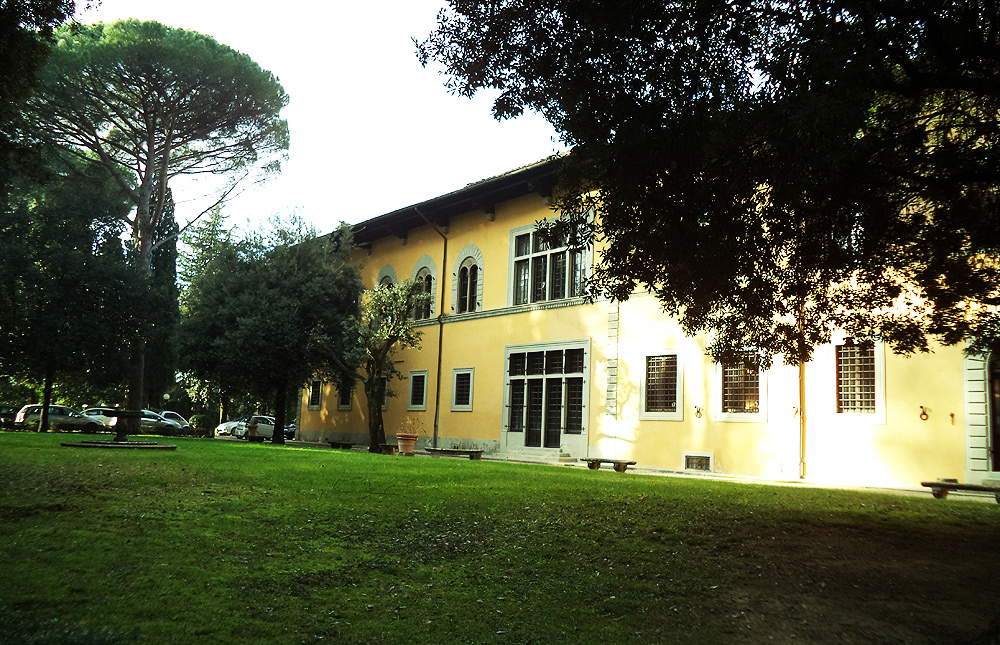 |
| Villa La Loggia in Florence. Ph. Credit Finestre Sull’Arte |
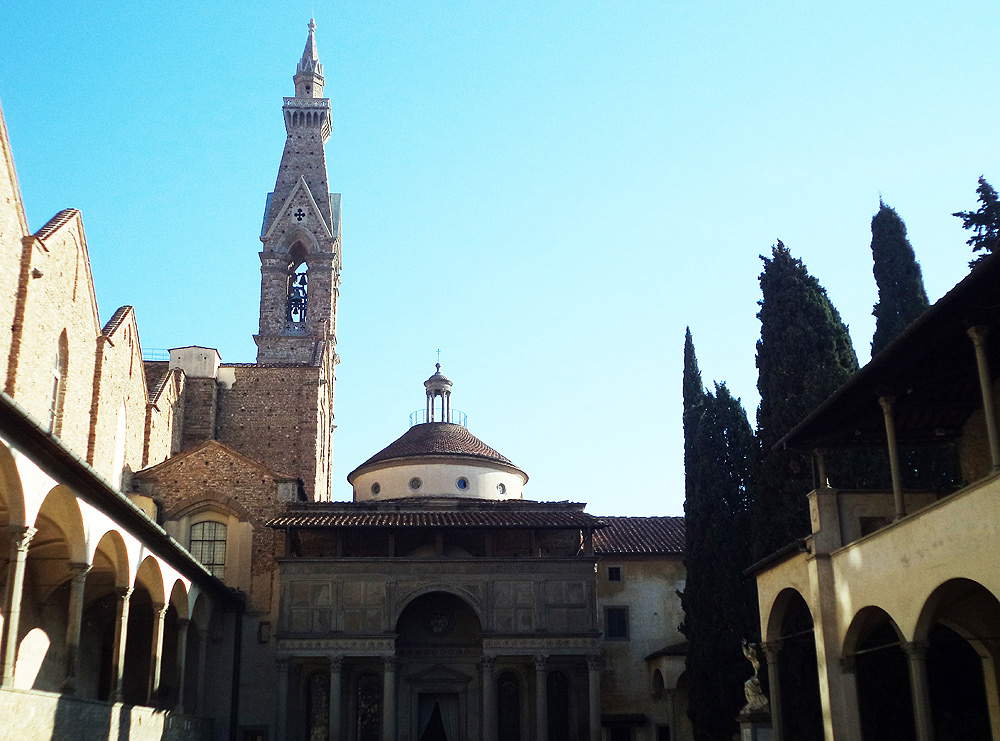 |
| The Pazzi Chapel. Ph. Credit Finestre Sull’Arte |
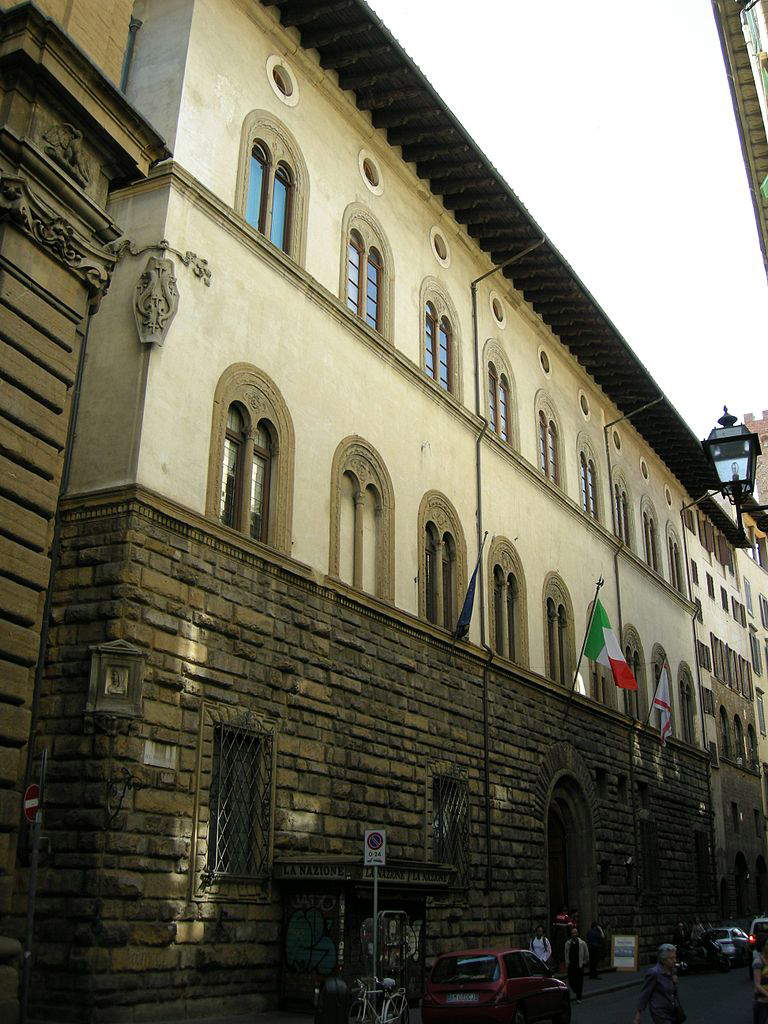 |
| Pazzi Palace in Florence. Ph. Credit Francesco Bini |
 |
| Donatello (attr.), Pazzi family coat of arms (first half of the 15th century; stone; Florence, Palazzo Pazzi) |
 |
| Giorgio Vasari, Portrait of Lorenzo the Magnificent (1533-1534; oil on panel, 90 x 72 cm; Florence, Uffizi) |
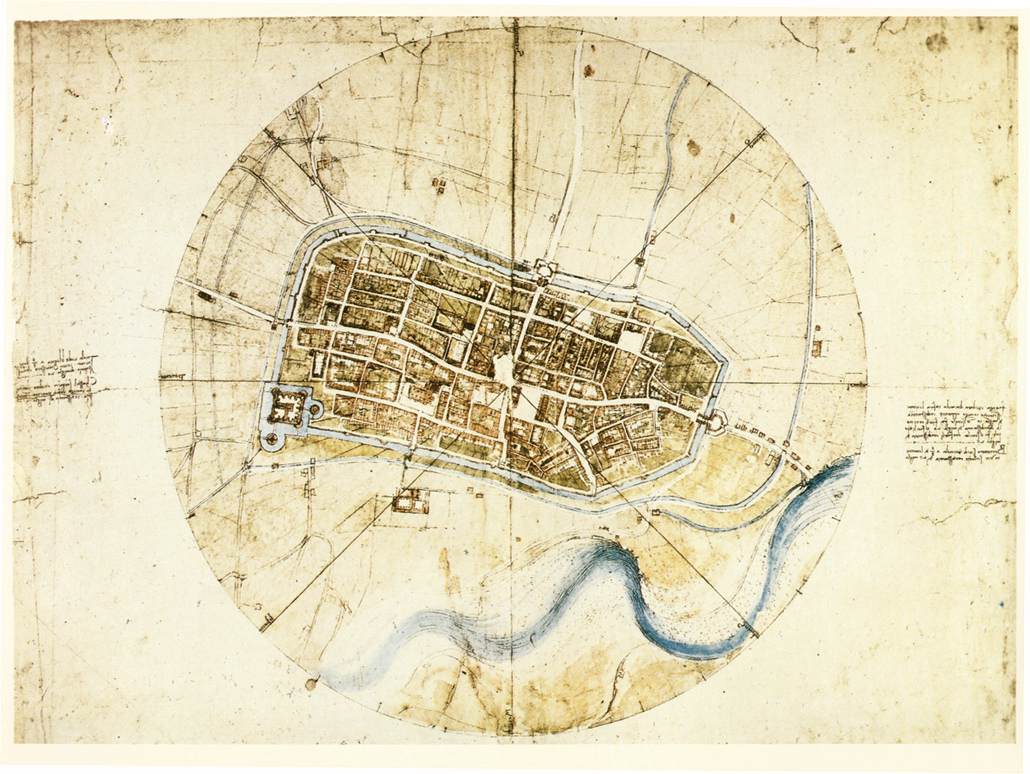 |
| Leonardo da Vinci, Map of the City of Imola (c. 1502; pencil and ink on paper, 440 x 602 mm; Windsor, Royal Library) |
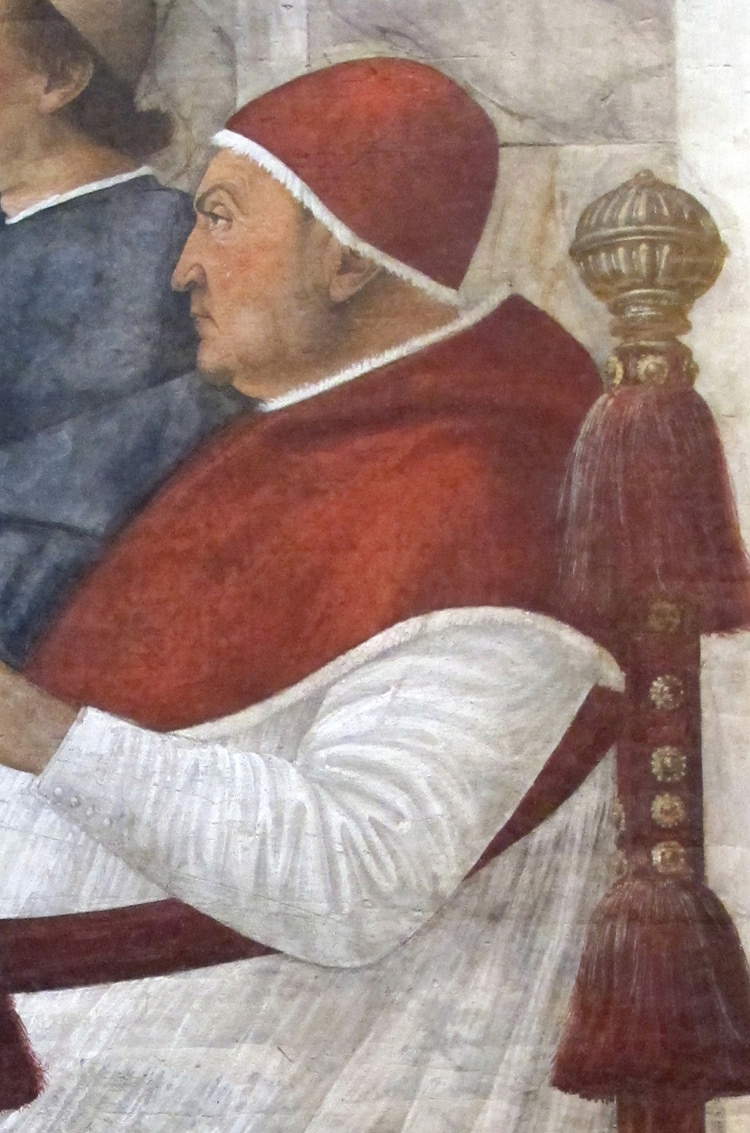 |
| Melozzo da Forlì, Sixtus IV appoints Platina prefect of the Vatican Library, detail of portrait of Sixtus IV (1477; detached fresco, 370 x 315 cm; Vatican City, Vatican Museums, Vatican Picture Gallery) |
 |
| Melozzo da Forlì, Sixtus IV appoints Platina prefect of the Vatican library, detail of the portrait of Girolamo Riario (1477; detached fresco, 370 x 315 cm; Vatican City, Vatican Museums, Pinacoteca Vaticana) |
It is thus this whole series of concauses, triggered by political, economic and idealistic motives, that made the conspirators mature the idea of killing the Medici: the straw that broke the camel’s back, however, according to some historians, is the rebellion of Perugia and other Umbrian centers against the authority of Pope Sixtus IV. It is feared that behind the sedition, and especially behind the one in Perugia, led by the condottiere Carlo Fortebraccio, was the Medici (and, specifically, Lorenzo’s) royalty, in order to bring the Umbrian cities under Florentine hegemony by removing them from papal influence. The conspiracy, which has already been planned for months, and has now taken on international proportions, may be accomplished: some of the most illustrious conspirators fear that it cannot wait any longer, because the risk is that the situation will become compromised, not least because the Medici already suspect, and are alerted by their allies (the Milanese above all), who have already sensed something.
Going back a little further in time and wanting to follow the account of Niccolò Machiavelli (Florence, 1469 - 1527) in Florentine Histories, it is possible to say that it is from the younger conspirators that the project starts: the first to harbor the desire to physically eliminate Lorenzo and Giuliano is Francesco de’ Pazzi who, in Rome where he has been residing for some time (partly because he is officially the pope’s treasurer, partly because he so hated the Florentine government that he could not bear the idea of having to live in the city), explains his intentions first to Girolamo Riario and then to Francesco Salviati, finding complicity. The three, however, cannot move without the approval of Jacopo de’ Pazzi: however, the head of the family is reluctant, and is opposed to his nephew’s idea. Francesco, Riario and Salviati therefore consider it essential to find support in the figure of Sixtus IV: if they can convince him, Jacopo cannot back down. Riario has no difficulty in illustrating the project to his very powerful uncle, who looks favorably on a change of regime in Florence but, given the moral offices conferred on him by his office, hopes that it will take place without bloodshed. The three young men thus hire a celebrated condottiere, Giovanni Battista da Montesecco (Montesecco, first half of the 15th century-Florence, 1478), and send him on a mission to Florence to meet the Magnifico and to report back to Jacopo that the audience of conspirators is widening: at first Jacopo is still skeptical, but having learned that the pope is in favor of overthrowing the Medici’s overpowering power, he is convinced and pledges factual support. Soon the conspiracy ceases to be confined to the sphere of rivalry between families, takes to involve many people and above all assumes, as anticipated, international proportions: recent studies have shown that Federico da Montefeltro (Gubbio, 1422 - Ferrara, 1482), the munificent and powerful duke of Urbino, is also implicated in the conspiracy. It is not known how the duke was approached, but it is certain that since he was also Gonfaloniere della Chiesa, that is, captain general of the papal army, he could not have been unaware of the plots of Girolamo Riario and Sixtus IV. The duke does not even think about the possibility of the conspiracy failing: for him, the problem is, if anything, the mode of execution. Again, the instigators of the conspiracy include the king of Naples, Ferrante of Aragon (Valencia, 1424 - Naples, 1494), who was probably approached by the Pazzi to whom he had granted favors (he had arranged for a Pazzi, Antonio, to become bishop of Sarno in 1475), and who was animated by anti-Medicean sentiments, which had for years been embodied in the reception given in Naples, to Florentine outcasts opposed to Medici policy, among whom was one who would later become, along with Francesco, Giuliano’s material assassin, Bernardo Bandini Baroncelli, a merchant of illustrious origins but fallen into financial disgrace, and who hoped, through the conspiracy, to restore his fortunes.
All the most illustrious conspirators harbored strong resentment against the Medici and, at the same time, would gain considerable advantage from the success of the conspiracy. Why Francesco de’ Pazzi and Francesco Salviati hated the Medici has been mentioned. Sixtus IV never forgave Lorenzo for the Imola affair, and the hatred grew after the support granted by the Magnifico to the revolting Umbrian cities. Riario also harbored resentment against Lorenzo for his opposition to the pope’s purchase of Imola, since the count’s plan (later successful anyway) was to become lord of the Romagna city. Federico da Montefeltro held Lorenzo in contempt because the latter had opposed his appointment as lieutenant governor of the Duchy of Milan after the assassination of Duke Galeazzo Maria Sforza. Ferrante of Aragon, on the other hand, was motivated by mere political calculations: the anti-papal alliance between Florence, Milan, and Venice, entered into through Lorenzo, had isolated Naples, not to mention the fact that Milan was tied to the Angevins, enemies of the Aragonese. A politically weaker Florence would therefore play in favor of the kingdom of Naples. And the same would apply to the Duchy of Urbino, which could expand westward and exert its influence on the Valtiberina as well: propositions impossible with a politically strong Florence. The same would apply to the pope, who could extend northward. The Pazzi are interested in economic hegemony over Florence as well as in tipping the Florentine political balance in their favor, and Riario and Salviati are also attracted by political beneficence.
 |
| Piero della Francesca, Portrait of Federico da Montefeltro (c. 1465-1472; oil on panel, 47 x 66 cm; Florence, Uffizi) |
 |
| Neapolitan ambit, Portrait of King Ferrante of Aragon (third quarter of 15th century; marble, 42 x 53 cm; Paris, Louvre) |
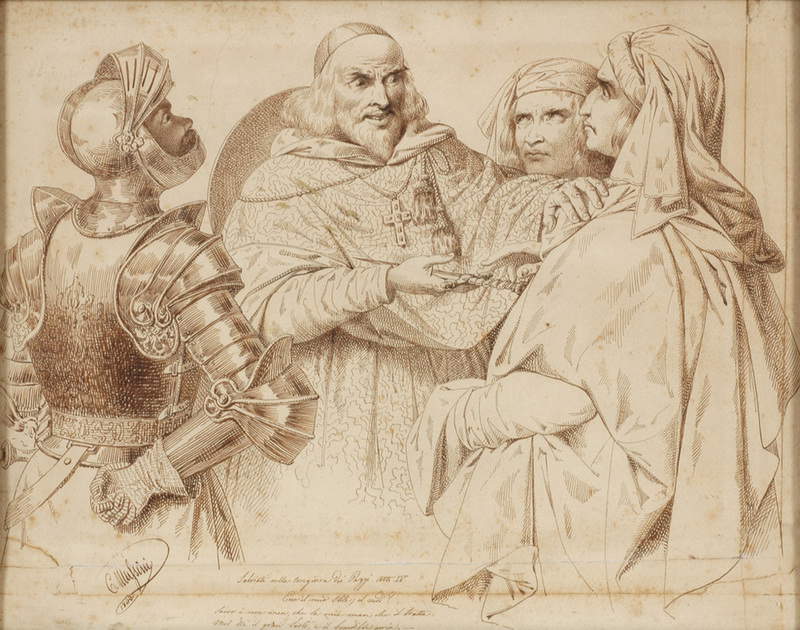 |
| Cesare Mussini, Salviati at the Pazzi Conspiracy (1843; watercolor, 35 x 44.2 cm; Private collection) |
We then move on to the enactment of the plan. The intent is to kill Lorenzo and Giuliano at the same time: one cannot run the risk of either of them surviving by gathering his men and especially the people around him. And it is necessary to eliminate them because, even in the event that the conspiracy succeeds but without killing as desired by the pope (who, moreover, as Montesecco will report during his trial, is said to have called his nephew Riario a “beast” for the violence of his intentions), one cannot expose oneself to the risk of the eventual return, with consequent revenge, of the two brothers. The occasion is provided by the banquet given by the Medici at their villa in Fiesole on Saturday, April 25, 1478, in honor of the very young Raffaele Riario (Savona, 1461 - Naples, 1521), Girolamo’s nephew and newly appointed cardinal by Sixtus IV: thus, plans are made to poison Lorenzo and Giuliano. A sudden indisposition of Giuliano, however, sends the plans of the conspirators astray. Everything is postponed until the next day, and the conspirators cannot afford to fail: the armies of the pope and Federico da Montefeltro are in the environs of Florence, ready to intervene at the outbreak of the unrest that will follow the murder of the two brothers. To delay the plan any longer would mean inevitably being discovered. Raffaele Riario has organized, just for Sunday, a mass of thanksgiving in the Duomo, and the conspirators determine that Lorenzo and Giuliano will be killed during the celebration. Giuliano is still ill, but the conspirators have to conclude the plan: Francesco de’ Pazzi and Bandini Baroncelli personally go to the Medici palace and offer to accompany him to the Duomo (in fact, it should be known that in public the Pazzi and the Medici do not let negative feelings show: on the contrary, they try to demonstrate a facade friendship, motivated also by close kinship). They pick him up, make sure he is not armed, and lead him to the church. Lorenzo was supposed to be taken care of by Giovanni Battista da Montesecco, but he refuses to kill a man in the church, especially since the condottiero has no personal grudge against Lorenzo (on the contrary: when he had met him, he had seemed to him like a very kind and affable man). The task is therefore entrusted to two priests, Stefano da Bagnone (Bagnone, 1418 - Florence, 1478) and Antonio Maffei (Volterra, 1450 - Florence, 1478), both of whom are linked to the Pazzi. All four appointed assassins, however, were inept with weapons: Francesco de’ Pazzi and Bandini Baroncelli got the better of Giuliano and succeeded in killing him only because the latter was ill and unarmed, but Francesco, unskilled with swords and daggers and blinded by hatred, in the heat of his violence wounded himself and sustained a serious injury to his leg. The two priests succeed only in wounding Lorenzo, who defends himself with his sword, using his cloak as a shield and getting help from some of his friends, including Poliziano himself: the Magnifico takes refuge in the sacristy and his escort bars access. Meanwhile, on the other side of the city, Archbishop Salviati with his men tries to seize the Palazzo Vecchio: the plan is to eliminate the gonfalonier Cesare Petrucci and, through a coup d’état, establish a new provisional government. Jacopo de’ Pazzi, on the other hand, is entrusted with the task of stirring up the Florentine people against the Medici, exalting freedom.
Interest in the most excited and dramatic phases of the conspiracy has meant that over the centuries several works of art have been dedicated to the theme of the conspiracy itself, and we can thus retrace the rapid succession of events, beginning with the killing of Giuliano, painted in a work by Stefano Ussi (Florence, 1822 - 1901), where the young man, depicted in anachronistic clothing, is at the center of the scene as he is stabbed by his assailants, who arrange themselves around him to deliver their blows without leaving him a chance. The historian Carlo Denina (Revello, 1731 - Paris, 1813) is said to have had his book Delle rivoluzioni d’Italia illustrated with engravings on the theme of the anti-Medicean conspiracy: thus we have the scene in which Lorenzo the Magnificent, wounded, is led into the sacristy where he is soothed and cared for by his friends. But there are also older works: the aforementioned exhibition The Stories of Botticelli. Between Boston and Bergamo in fact exhibited a rare portrait of Giuliano who was stabbed, an engraving that accompanies the Elogia virorum bellica virtute illustrium by Paolo Giovio (Como, 1483 - Florence, 1552), a collection of biographies of illustrious men written by the Lombard historian in 1551 and published in several editions.
 |
| Stefano Ussi, The Pazzi Conspiracy (second half of the 19th century; oil on canvas, 41 x 61 cm; Private collection) |
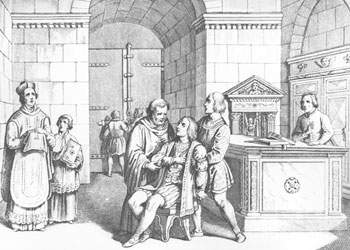 |
| Carlo Denina, Lorenzo de’ Medici wounded during the Pazzi conspiracy, from the Italian Revolutions (1846; engraving) |
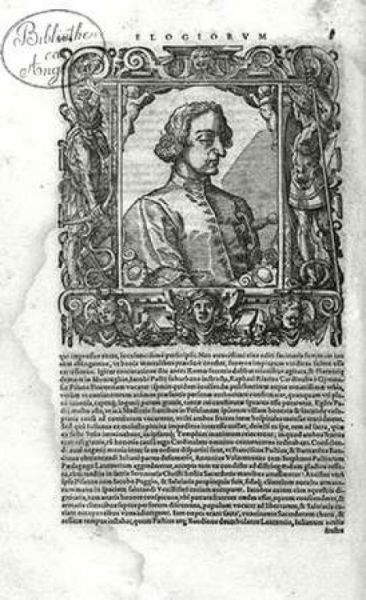 |
| Paolo Giovio, Giuliano de’ Medici stabbed, from the Elogia virorum bellica virtute illustrium (1575; woodcut engraving, 160 x 148 mm, printed in Basel, printing house of Pietro Perna; various locations) |
To return to the story, the plans do not go as the conspirators planned: not only because Lorenzo survives, but also because the Pazzi underestimated the reaction of the Florentines. Petrucci, a man loyal to the Medici, becoming suspicious of Salviati’s attitude, becomes aware of the archbishop’s intentions: a scuffle ensues where the pro-Medicians get the upper hand, and Salviati, along with other conspirators including the man of letters and humanist Jacopo Bracciolini (Florence, 1442 - 1478), son of the famous Poggio Bracciolini, is captured only to be summarily tried and then hanged from the windows of the Palazzo Vecchio. Francesco de’ Pazzi, severely wounded, takes refuge in the family palace to medicate himself, but an angry mob catches up with him, begins to loot Palazzo Pazzi, and the young banker, barely escaped from the clutches of the people who want to lynch him, is taken to Palazzo Vecchio, where he suffers the same fate as Salviati (indeed: he is hung along with him but, unlike the archbishop who appears confused and distraught, during the summary trial Francesco remains impassive and proud). Jacopo’s moves are well summarized by Machiavelli, who spares no remarks on the people of Florence, who are not very accustomed to freedom: “messer Jacopo, though old, and in such tumults not practiced [...] mounted his horse with perhaps a hundred armed men, who had been before for such an enterprise prepared, and went to the square of the Palagio, calling the people and freedom to his aid. But because the one was by the fortune and liberality of the Medici made deaf, the other in Florence was not known, he was answered by no one.” Not knowing what to do, Jacopo flees and tries to take shelter in Romagna. However, he is caught up in the Apennines, handed back to the Florentines, and executed four days after the conspiracy (and his corpse will be disposed of a few days later: some Medici partisans dig him up, carry him around the city in mockery and contempt, come to the macabre resolution of presenting the body in front of Palazzo Pazzi, and finally throw him into the Arno, and among the more sarcastic some comment that Jacopo had more of a following dead than alive). Montesecco is also captured, but because he refused at the last to take part in the conspiracy and actively cooperates with justice (his confessions are one of the most valuable pieces of evidence for reconstructing the plots of the Pazzi conspiracy), and especially because he holds the title of knight, he is spared the shame of hanging and is executed by beheading, a punishment deemed more honorable. The two religious men, Maffei and Stefano da Bagnone, take refuge in the monastery of the Florentine Badia, but a few days later they are captured, mutilated, and hanged. Bandini Baroncelli is the only one who manages to lose track of them: however, he is spotted a year later in Istanbul, and brought back to Florence he too is hanged: famous is the drawing by Leonardo da Vinci (Vinci, 1452 - Amboise, 1519) that depicts the conspirator hanging, still wearing his Turkish-style clothes, a sign that he had not even been given a chance to change.
Lorenzo, once he realized that the situation was turning in his favor, went back to his palace and, without daring to leave his house for at least a dozen days, took advantage of the unrest to eliminate all forms of opposition without moving a finger and without directly staining himself with any crime, but simply collecting the fruits of his propaganda: on the night of April 26-27 alone, about eighty people died, including guilty and presumed guilty, since the fury of the Medicean partisans was unleashed in all its horrific ferocity (Poliziano, in his commentary, recalls corpses being thrown here and there in the streets, on which the population was raging). The Pazzi family, “believed en bloc to be involved in the conspiracy and therefore guilty,” write Cardini and Frale, is destroyed: as mentioned, Jacopo and Francesco die, and the same happens to one of Jacopo’s nephews, Renato, who though not involved in the conspiracy is captured and hanged as he tries to escape after realizing that staying in Florence is not prudent. Guglielmo survives only because he is Lorenzo’s brother-in-law, but he is immediately banished from the city. Giovanni and other family members are captured and imprisoned in Volterra. Then begins the damnatio memoriae, which is consummated by the confiscation of their property and the destruction of all signs of their presence in the city (which is why no portraits of the Pazzi have come down to us). For the family it is the beginning of an unstoppable and definitive decline. Florence remains in turmoil and emergency: armies of soldiers roam the city, and even the lord of Bologna, Giovanni Bentivoglio, a friend of the Medici, sends a contingent to help the family. As for the illustrious members of the conspiracy, just after the events of April 26, the pope and his allies move a war against Florence (the pretext is the killing of clerics) destined to last for two years. Finally, proper honors are bestowed on Giuliano: the sculptor Bertoldo di Giovanni (Florence, c. 1420 - Poggio a Caiano, 1491), also known to have been among Michelangelo’s first masters, is commissioned to design the commemorative medal (on display at the Bergamasque exhibition), made in 1478 itself. It represents a very rare case of a topical event immortalized by a 15th-century artist: on one of the sides of the medal, the conspirators turn on Giuliano while Lorenzo tries to defend himself, while on the other side Giuliano is already on the ground lifeless and Lorenzo tries to escape the assassins’ blows. Also depicted in the scene is young Francesco Nori, one of the men in the Magnifico’s retinue, who interposes himself between the assassins and the lord and sacrifices his life to save Lorenzo’s. Above the two scenes appear instead portraits, in profile, of the two brothers. Bertoldo di Giovanni uses his proven skill as a medallist to render, with intense and surprising narrative vividness, an episode contemporary to him: this is one of the first instances in the history of art.
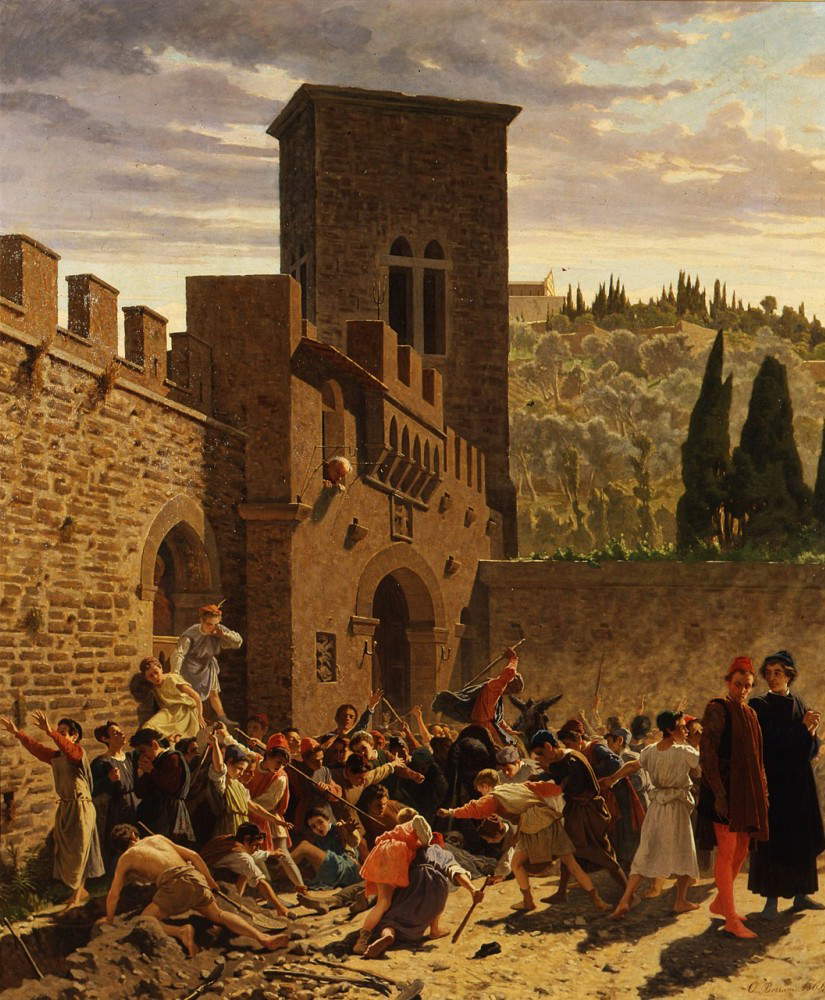 |
| Odoardo Borrani, The Corpse of Jacopo de’ Pazzi (1864; oil on canvas, 145 x 121 cm; Florence, Galleria d’Arte Moderna di Palazzo Pitti) |
 |
| Leonardo da Vinci, Bernardo Bandini Baroncelli hanged (1479; ink on paper, 192 x 78 mm; Bayonne, Musée Bonnat) |
 |
| Bertoldo di Giovanni, Medal of the Pazzi Conspiracy, recto (1478; bronze, 6.56 x 6.56 cm; Various collocations) |
 |
| Bertoldo di Giovanni, Medal of the Pazzi Conspiracy, verso (1478; bronze, 6.56 x 6.56 cm; Various collocations) |
Historians have long wondered about the reasons that led to the failure of a conspiracy that had been elaborated for months, if not years, and involved the involvement of important and influential figures. The response of the Florentine people (who, moreover, as Poliziano testifies, loved Giuliano), underestimated by the Pazzi (the Medici partisans, Cardini and Frale point out, confronted those of the Pazzi "by responding to the noble but somewhat demodé ’Popolo e Libertà!’ with the plebeian, sanguine ’Balls, Balls, Balls’“ in reference to the Medici coat of arms with six spheres on a gold field), and the unwise calculation that a crime in the church (and thus a sacrilege) would have been considered particularly odious by the populace, in themselves are not sufficient reasons to explain why the failure occurred: they can, if anything, help us understand why the contingency occurred, but they are not enough on their own to undermine the scaffolding of the conspiracy, especially with regard to its international ramifications. Not least because we need to consider that, in any case, Girolamo Riario is in no way undermined by the Medici revenge, and the main international players in the conspiracy, from the pope to the king of Naples via the duke of Urbino, are all alive and now at war against Lorenzo the Magnificent. As for the domestic front, Lorenzo had succeeded in compacting the families of the Florentine oligarchy in a pro-Medicean sense by guaranteeing their participation in power while obtaining in return recognition of his role as arbiter in city politics. Well illustrating the contradictions ”of an oligarchy of republican tradition and sentiments, which nevertheless, by the very definition of its role, accepted a relationship of subordination," historian Riccardo Fubini has written, is precisely the aforementioned dialogue De libertate by Alamanno Zanobi Rinuccini, which nevertheless remains an isolated voice. On the other hand, as far as the foreign front is concerned, the pope and the king of Naples will indeed engage in a war against Florence, but animated by different intentions: the only motive that unites them is precisely the war against the Tuscan city. Fubini points out that the Magnifico will act by leveraging the diversity of intentions, seeking an agreement for peace with Ferrante of Aragon “on the basis of a guarantee, to which he would remain faithful, vis-à-vis the Franco-Angevin threat,” and thus succeeding in forging an alliance with Naples (loosening the one with Milan). In 1480, with the onset of the Ottoman threat (the Turks that year went so far as to sack Otranto), Sixtus IV was also persuaded to end the war with Florence by making peace. And as a sign of détente, Lorenzo will send, in 1481, some of the greatest Florentine artists (Sandro Botticelli, Cosimo Rosselli, Ghirlandaio) to decorate the Sistine Chapel, commissioned by the della Rovere pope. Ultimately, Medici propaganda, after the conspiracy, would focus on placing all the blame on the Pazzi, trying to keep quiet about the evidence of foreign sovereigns’ involvement so as not to jeopardize the stability of Italy.
It has been said that the Pazzi Conspiracy was above all the result of an imbalance in the international political arrangements in fifteenth-century Italy: partly by virtue of these facts, from 1478 onward Lorenzo the Magnificent’s political action would be devoted to keeping the political fortunes of Italy and its states in perfect balance, and this would earn him the very famous appellation of “the needle in the balance of Italian principles” affixed to him by Guicciardini. His position after the conspiracy will prove to be extraordinarily strengthened, and from the 1980s onward, Lorenzo will be able to rule the city almost like a prince (though still without ever obtaining official positions), concentrating power in his own hands.
Reference bibliography
Warning: the translation into English of the original Italian article was created using automatic tools. We undertake to review all articles, but we do not guarantee the total absence of inaccuracies in the translation due to the program. You can find the original by clicking on the ITA button. If you find any mistake,please contact us.